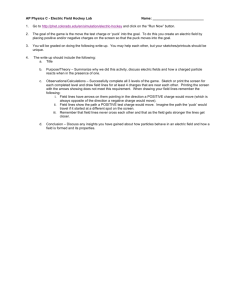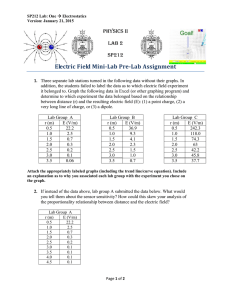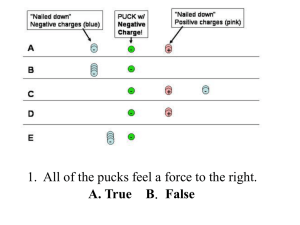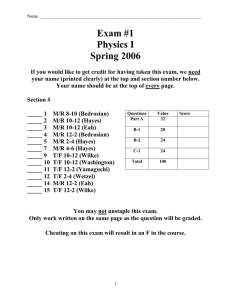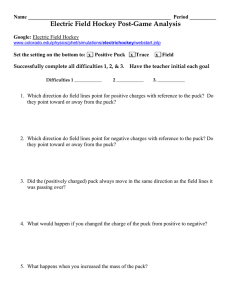Exam #1 Physics I Fall 2003
advertisement
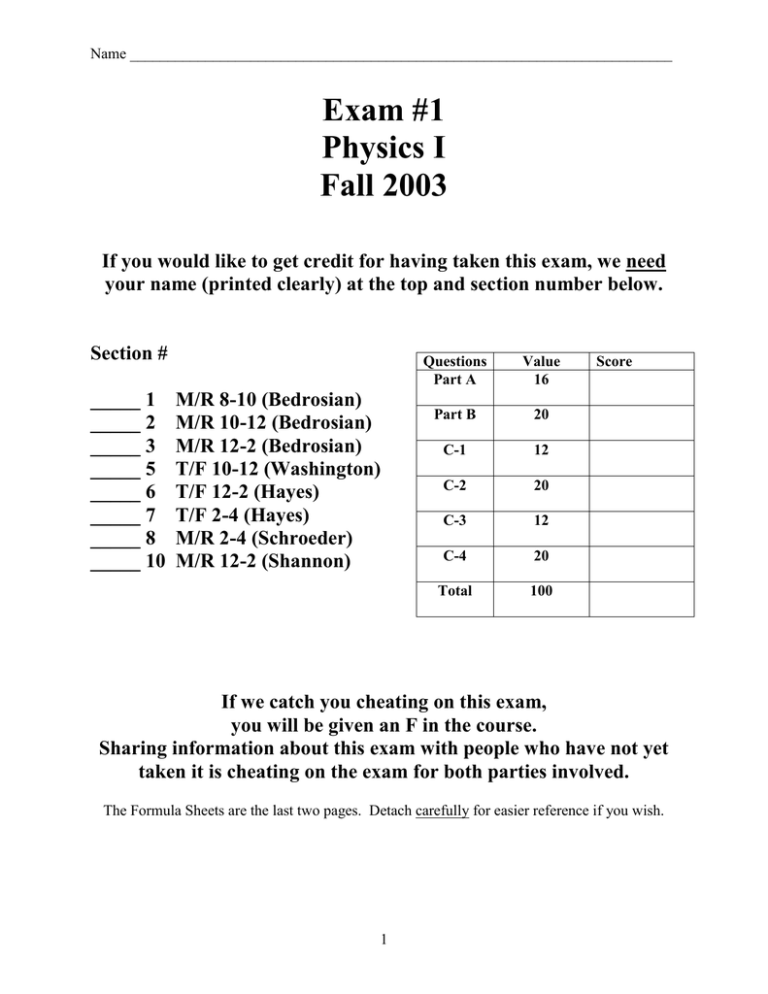
Name ________________________________________________________________________ Exam #1 Physics I Fall 2003 If you would like to get credit for having taken this exam, we need your name (printed clearly) at the top and section number below. Section # _____ 1 _____ 2 _____ 3 _____ 5 _____ 6 _____ 7 _____ 8 _____ 10 M/R 8-10 (Bedrosian) M/R 10-12 (Bedrosian) M/R 12-2 (Bedrosian) T/F 10-12 (Washington) T/F 12-2 (Hayes) T/F 2-4 (Hayes) M/R 2-4 (Schroeder) M/R 12-2 (Shannon) Questions Part A Value 16 Part B 20 C-1 12 C-2 20 C-3 12 C-4 20 Total 100 Score If we catch you cheating on this exam, you will be given an F in the course. Sharing information about this exam with people who have not yet taken it is cheating on the exam for both parties involved. The Formula Sheets are the last two pages. Detach carefully for easier reference if you wish. 1 Name ________________________________________________________________________ On this exam, please neglect any relativistic and/or quantum mechanical effects. If you don’t know what those are, don’t worry, we are neglecting them! On all multiple-choice questions, choose the best answer in the context of what we have learned in Physics I. On numerical questions, show all work to receive credit. Part A – Warm-Ups – 16 Points Total (4 at 4 Points Each) Write your choice on the line to the left of the question number. ______ 1. Which of the following statements is not one of Newton’s Laws of Motion? A) All objects fall with equal acceleration regardless of mass. B) Objects at rest tend to stay at rest and objects moving with a constant velocity maintain that velocity unless acted on by a force. C) F Fnet m a D) For every action there is an equal and opposite reaction. ______ 2. Three books (X, Y, and Z) rest on a table. The weight of each book is indicated. The net force acting on book Y is: A) 4 N down. B) 5 N up. ______ 3. E) None of these. Two blocks are connected by a string and pulley as shown. Assuming that the string and pulley are massless and frictionless, and using g = 9.8 m/s2, the tension in the string is: A) Zero. ______ 4. C) 9 N down. D) Zero. B) 4.9 N. C) 9.8 N. D) 19.6 N. E) None of these. For this question, take right as the positive direction. A 0.25 kg rubber ball traveling horizontally to the left at 12 m/s hits a wall and bounces back at 8 m/s to the right. The total impulse exerted by the wall on the ball is A) –5.0 N s. B) +5.0 N s. C) –3.0 N s. D) +3.0 N s. E) –2.0 N s. F) +2.0 N s. G) –1.0 N s. H) +1.0 N s. 2 Name ________________________________________________________________________ Part B – Graphing – 20 Points Total Draw graphs of position (x) and acceleration (a) based on the graph of velocity (v) versus time (t) shown below. The graph of v is composed of straight line segments. Assume x = 0 at t = 0. Make sure that your graphs show the following features: 1. General shapes of the curves, noting any points where the curvature or slope changes. 2. The values of x at the following times: 4, 7, and 10 seconds. 3. The time when x reaches the maximum and its value at that time. 4. The values of a at the following times: 2, 5, 8, and 10 seconds. x (m) 0 t (sec) 2 4 6 8 10 v (m/s) +4 t (sec) 0 2 4 6 8 10 -4 a (m/s2) t (sec) 0 2 4 6 8 10 3 Name ________________________________________________________________________ Part C – Problems – 64 Points Total C-1 (12 points) An astronaut hit a golf ball on the moon and gave it an initial speed of 33.4 m/s at an angle 15.0° up from horizontal. How far did the ball travel horizontally when it reached its maximum height? Use gmoon = 1.67 m/s2. Note: If you want to use the “range equation” you must derive it from the formulas on the sheet. maximum height horizontal distance Horizontal Distance at Maximum Height: _________________________ units _______ 4 Name ________________________________________________________________________ C-2 (20 points) Mass m3 can slide in one dimension on a frictionless track. It is connected by strings at either end via pulleys to hanging masses m1 and m2 as shown in the figure below. Neglect the mass of the strings and pulleys and neglect all sources of friction. Assume m2 > m1. In this problem, we will use the following variables: Masses: m1, m2, m3 String Tensions: T1, T2 Acceleration of mass m3: a (positive to the right) Acceleration constant of gravity: g T1 m3 T2 m1 m2 (a) Find the tension in the string attached to m1 in terms of m1, a, and g: T1 = _________________________________________________ (b) Find the tension in the string attached to m2 in terms of m2, a, and g: T2 = _________________________________________________ (c) Find the acceleration of m3 in terms of m1, m2, m3, and g: a = __________________________________________________ 5 Name ________________________________________________________________________ C-3 (12 points) The space shuttle Atlantis is in a circular orbit 100. km (1.00 x 105 m) above the surface of the earth. (This is an example of uniform circular motion.) At this height, the acceleration constant of gravity is g = 9.53 m/s2. The radius of the earth is 6.37 x 106 m. How long (in minutes) does it take for the shuttle Atlantis to complete one orbit? Time for One Orbit: _______________________ units: _minutes_ 6 Name ________________________________________________________________________ C-4 (20 points) A hockey puck (Puck A) sliding on frictionless ice collides with another puck (Puck B) initially at rest. Each puck has mass = 0.150 kg. The initial velocity of Puck A is 10.0 m/s in the +X direction. The net force on Puck B during the collision versus time is shown on the graph below. The direction of this force is 50.0° counter-clockwise from the +X axis. Find the velocities of Pucks A and B after the collision. (Suggestion: Find the velocity of Puck B first.) Force on Puck B at 50.0° (N) before collision 40.0 Puck B Puck A Y 10.0 m/s F 0 X t (sec) 0 0.04 Vx of Puck A: _____________________________ units: _______ Vy of Puck A: _____________________________ units: _______ Vx of Puck B: _____________________________ units: _______ Vy of Puck B: _____________________________ units: _______ 7 Name ________________________________________________________________________ Formula Sheet for Homework and Exams – Page 1 of 2 1. v v 0 a t t 0 21. 2. x x 0 v 0 ( t t 0 ) 12 a ( t t 0 ) 2 K 12 m v 2 12 m (v x v y ) 22. 3. x x 0 12 ( v0 v)( t t 0 ) 23. K f K i Wnet U Fcons dx 4. x x 0 v( t t 0 ) 12 a ( t t 0 ) 2 24. U g m g (y y 0 ) 25. U s 12 k ( x x 0 ) 2 26. 27. 28. K U Wnoncons s r v tangential r a tangential r 2 2 6. v 2 v 02 2a x x 0 F Fnet m a 7. T 8. a centripetal 29. 30. 0 t t 0 Fcentripetal p mv dp F Fnet d t J Fnet dt p P pi dP Fext dt 31. 0 0 ( t t 0 ) 12 ( t t 0 ) 2 32. 0 12 (0 )( t t 0 ) 33. 0 ( t t 0 ) 12 ( t t 0 ) 2 M mi 38. 5. 9. 10. 11. 12. 13. 14. 15. 16. 17. 18. 19. 20. 2r v v2 2 r r v2 m m 2 r r 35. 2 02 2 0 a b a b sin( ) 36. I m i ri 34. 37. 39. 1 1 x cm m i x i y cm m i y i M M P M v cm a b a b cos() a x b x a y b y W Fd W F dx 40. 41. 42. 43. 44x. m1 v1, x ,before m 2 v 2, x ,before m1 v1, x ,after m 2 v 2, x ,after 44y. m1 v1, y ,before m 2 v 2, y ,before m1 v1, y ,after m 2 v 2, y,after m1 m 2 2 m2 v1,i v 2 ,i m1 m 2 m1 m 2 2 m1 m m1 v1,i 2 v 2 ,i m1 m 2 m1 m 2 45a. v1,f 45b. v 2,f 8 2 K rot 12 I 2 W d r F dL I d t l r p L l i L I Name ________________________________________________________________________ Formula Sheet for Homework and Exams – Page 2 of 2 m m 46a. | F | G 1 2 2 r m m 46b. F G 1 2 2 r̂ r 1 | q1 || q 2 | 47a. | F | 4 0 r2 1 q1 q 2 47b. F (r̂ ) 4 0 r 2 1 | qi | 48a. | E i | 4 0 ri 2 1 qi (r̂i ) 48b. E 4 0 ri 2 49. F q E 50. 51. 52. 1 qi 4 0 ri U qV V E dx V V x V 53y. E y y 54. F q v B mv 55. r qB 53x. E x Useful Constants (You can use the approximate values on tests.) Universal Gravitation Constant G 6.67310 11 N m 2 kg 2 6.67 10 11 Electrostatic Force Constant 1 8.987551788 10 9 N m 2 C 2 9.0 10 9 4 0 Magnetic Constant 0 4 10 7 H m 1 1.26 10 6 Speed of Light in Vacuum c 2.99792458 10 8 m s 1 3.010 8 Charge of a Proton e 1.602176462 10 19 C 1.6 10 19 Electron-Volt Conversion Constant 1eV 1.602176462 10 19 J 1.6 10 19 Mass of a Proton m p 1.6726215810 27 kg 1.67 10 27 Mass of an Electron m e 9.10938188 10 31 kg 9.110 31 9
